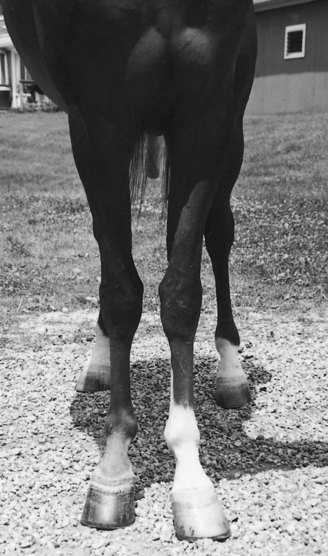Chapter 123Lameness in the Arabian and Half-Arabian Show Horse
History of the Sporting Event
Performance classes for Arabian and Half-Arabian horses cover a broad spectrum and are listed in Box 123-1. Each of these classes is held separately for Arabians and Half-Arabians. They may be divided further into sections for junior owner, adult amateur owner, amateur owner, junior exhibitor, and amateur. The Park horse has a strong animated trot, with the forearm horizontal and the limb extending fully forward. The hock has a well-raised driving action. The walk and canter are animated and collected. The English Pleasure horse is shown at a walk, trot, strong trot (faster and more animated than the normal trot), canter, and hand gallop. Its gaits are less animated than those of the Park horse, although the forearm, at the trot, is horizontal. The same gaits are used in the Country English Pleasure class, but horses have lower limb action, and high action is penalized. The Country English Pleasure horse must also halt, stand quietly, back, and walk off on a loose rein. With all pleasure classes the horse must give the appearance of being a pleasure to ride. Park horses and English Pleasure horses are shown with the head carried high and considerable flexion at the poll. Saddle seat attire is required.
Training: Impact of Industry
The Arabian and Half-Arabian are versatile breeds, as shown by the many sports in which they compete. These include halter, endurance (see Chapter 118), pleasure, jumping, dressage, reining, cutting, and racing (see Chapter 111). Young performance horses are not shown under saddle until they are 3 years old. They then compete in futurity classes for horses 3 years of age or junior horse classes for horses 5 years of age or younger. Because these horses do not compete in performance classes until 3 years of age, this allows more time for adequate skeletal development compared with racehorses and Quarter Horses that start training before 2 years of age. The reason that training of Arabian show horses is started later than some other breeds may be partly smaller size and late maturation, but it is also related to the fact that no performance classes are available for 2-year-olds, and therefore no economic incentives exist to start intensive training early.
Conformation and Lameness
Mild-to-moderate carpus valgus and toed-out conformation commonly are seen and do not appear to have a major impact on soundness (Figure 123-1). One reason is that the carpus is not a common location for lameness. If these conformational faults are severe, horses are at risk of suspensory desmitis. Horses with long sloping pasterns, back-at-the-knee conformation, or offset knees are also predisposed to suspensory desmitis. These conformational faults are more common in the Half-Arabian and National Show Horse than in purebred Arabians and are more common in certain pedigrees.




